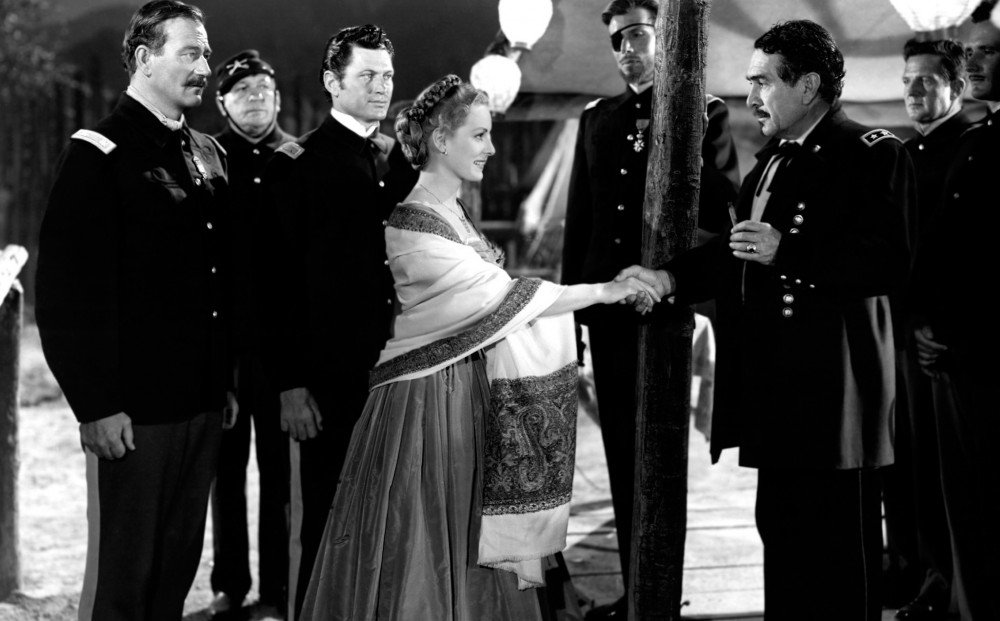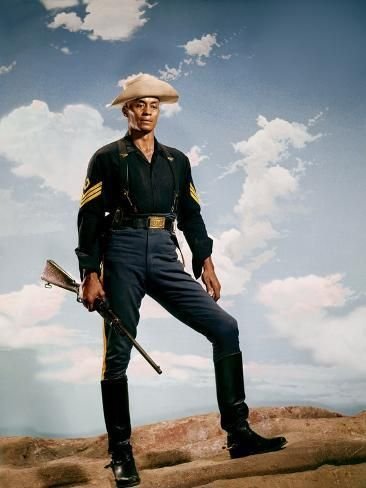John Ford Chapters 9 & 10: Ford's Fractured Families & Ford's Finales by Craig Hammill
As part of our The Ford Fundamentals: John Ford Director of 2022 series, founder.programmer Craig Hammill is writing an appreciation in 12 chapters, a prologue, and an epilogue across the year.
Important Note: Movies will be talked about in depth so definitely spoilers!
CHAPTER 9: Ford’s Fractured Families
The decade from 1940 through 1950 found John Ford often returning to the theme of the family under pressure, torn apart, reconciled, or even completely fabricated (yet ultimately cohering into something real). Three of these pictures-The Long Voyage Home (1940), Three Godfathers (1948), and Rio Grande (1950)-serve as fascinating sketchbooks for themes Ford would fully develop in masterpieces that shortly followed. And Rio Grande is itself a masterpiece that sets up an even bigger masterpiece (The Quiet Man).
John Ford was always coming back to questions of the family. If Howard Hawks made movies about groups of people being unsentimental professionals in tough situations, John Ford made movies about disparate communities and individuals coming together for the greater good to form family or society and most often America.
The Long Voyage Home (1940), stitched together from several Eugene O Neil one act plays, follows a group of salty sailors carrying explosives to England for the nascent war effort against the Nazis. At first blush, this is Hawksian. And indeed the Hawksian themes of doing the job and accepting the risks are there. But in John Ford’s hands (with a huge assist from Citizen Kane cinematographer Gregg Toland), the movie really becomes about how misfit men both tragically avoid and earnestly form family in their strange lifestyle. The Long Voyage Home is one of Ford’s most cinematically beautiful and underrated movies. Ford does a masterful job here of establishing the personalities and quirks of each of the sailors so that any death or departure feels like the loss of a brother or son. The final sequence of the movie in which the sailors are determined to get young Olie (John Wayne) on a boat back to his family in Sweden (so that Olie doesn’t re-enlist and get doomed to live his life alone at sea) is both hilariously funny and unspeakably tragic. The genuine fatherly love the older sailors have for young Olie battles with their wayward ways as they give in to the temptations of drink and women and forget about their charge. Ford hits on a profound irony here-these sailors who have all rejected traditional family life deeply yearn for it for a younger man not yet set in his ways.
The Long Voyage Home is also one of the first Hollywood movies to take a stand (if subtle) encouraging the United States to get involved in the European war against fascism. Ford again proved himself able to incorporate controversial themes into his work and make them digestible for a larger more ambivalent audience. These skills must have been a huge part of the reason Ford endured so many eras of filmmaking and why Fox studio head Daryl Zanuck would entrust controversial difficult literary works like The Grapes of Wrath and How Green Was My Valley to Ford. Ford would find a way to stay true to the soul of the works while making them palatable to larger more skeptical mainstream audience suspicious of the source material’s political affiliations. In fact, Ford’s focus on the family dynamics of the migrant farmer Joad family in a movie like The Grapes of Wrath helps to smuggle in a blistering indictment of worker exploitation and an endorsement of FDR’s New Deal policies. It’s hard to imagine any other filmmaker besides maybe Frank Capra willing or able to pull something like that off in a major Hollywood entertainment.
Eight years later, Ford would remake a favorite silent western he had done in the early days with Harry Carrey-Marked Men (which itself was a remake of 1916’s Three Godfathers also starring Carrey but directed by Edward LeSaint)-as Three Godfathers (1948). A technicolor fairy tale about three outlaws (John Wayne, Pedro Armendariz, and Harry Carry Jr) who become Godfathers to a baby they help deliver in the desert and become determined to get it to safety even at the expense of their own lives and capture. Shot by Winston C. Hoch in gorgeous color, Three Godfathers is one of John Ford’s sweetest movies. The biblical Nativity symbolism is front and center. Ford even drives the point home by having the whole story take place at Christmas.
While the movie’s simplicity and intentional fable like tone keep it from achieving the strange ambiguous complexity of Ford’s greatest work, Three Godfathers still finds Ford getting his sea legs with color. While Drums Along the Mohawk (1939) would be Ford’s first major movie in color, Three Godfathers marks Ford’s embrace of a technology he can see will come to dominate moviemaking. Interestingly, while masters like Akira Kurosawa and Federico Fellini never managed to make all-time masterpieces in color (Ran and Juliet of the Spirits are absolutely masterpieces just not those moviemakers BEST masterpieces), John Ford made two of his greatest movies ever in color-The Quiet Man and The Searchers. Showing the Old Man smart enough to learn and adapt to the new technologies of the industry.
Many see the Ford masterpiece Rio Grande (1950) as a clear rough draft for Ford’s 1952 classic The Quiet Man. Ford had never been totally comfortable making movies whose central focus was a romance. He was always much more at ease having any romance be a side-story on an even playing field with other competing narratives. But in Rio Grande which tells the story of the estranged military York family brought together for reconciliation during a dangerous pursuit of outlaw Apache along the Mexican border, Ford squarely commits himself to concentrating on the romantic reapproachment between John Wayne’s and Maureen O Hara’s separated husband and wife. The chemistry is so palpable between the two leads that there must have been no doubt in Ford’s mind that they would be the two to play his lovers Sean Thornton and Mary Kate Danaugher in The Quiet Man.
Rio Grande, the last of Ford’s cavalry trilogy (Fort Apache and She Wore a Yellow Ribbon being the first two, all three being bangers in one way or another), also shows Ford at a moment of extreme schism. Its view of Native Americans is surprisingly retrograde and one dimensional for a Ford picture. So much so that it has been theorized that the Native Americans here are really stand-ins for Communists during the Red Scare. This writer isn’t sure that gets Ford off the hook either way. Ford usually took pains to humanize Native Americans and their motivations, something that would have been appreciated here. But this writer does know that the family reconciliation storyline is the dominant and powerful storyline of the picture. Ford may have been making a western to make some money before attempting his risky Irish fairy tale The Quiet Man but he was also, once again, returning to his obsessive focus of the Paradise Lost and Found of what families can be, what they often are, and what they can become again with grace.
While Rio Grande is a flawed masterpiece, it is a masterpiece nonetheless. And showed that Ford at the start of the 1950’s and his fifth decade as a filmmaker had lost none of his power as a director. In fact, if anything, Rio Grande proved he still had several bangers left in him. And his constant refinement of his obsessive theme of families or communities formed, forged, torn apart, and sometimes brought together again would find some of their fullest expressions in his 1950’s masterpieces Wagon Master, The Quiet Man , and The Searchers.
CHAPTER 10: Ford’s Finales
In the final five years of John Ford’s active career he would make three revisionist movies that served to redress or clarify his positions on Native Americans, the diversity of America, and the equality of all peoples as a birthright. Sergeant Rutledge (1960) would be his definitive and blistering civil rights movie, Cheyenne Autumn (1964) would be his pulling out all the stops 70mm epic about the mistreatment of Native Americans, and 7 Women (1965), his final feature, would find him a feminist years ahead of the pack. While all the movies are flawed, they do represent Ford willing to use his cache to make definitive statements on where he stood on key questions of American identity.
John Ford was a man of contradictions. He was a consummate professional able to stick to the budget and schedule. He was also a lifelong alcoholic who would go on epic benders and, on rare occasion, lose control as he did on 1954’s Mr. Roberts. He was a deeply sensitive man who went to great lengths to take care of and stay loyal to his cast and crew including the Navajo extras he regularly employed in Monument Valley, crew members, and bit actors who had worked for him decades before. He was also notoriously abusive, aloof, and verbally assaultive, traits his brother Frank observed that Ford used to mask Ford’s natural softness.
The contradictions don’t stop there. As many have noted, there are often competing allegiances in Ford's films. And after World War II, Ford’s commitment to and belief in the American system would often manifest itself in a fairly committed pro-military, pro-interventionist world view. Ford supported both Korea and Vietnam (even if he was also intelligent enough to be skeptical of them in private). And his collaborations with John Wayne would make him increasingly appear to many younger filmmakers, critics, etc as being a filmmaker who had become conservative, reactionary, and out of step in his older years.
BUT actually watching Ford’s late period films show Ford actually making some of the riskiest progresssive movies of the era (though done, as always, in a classic Fordian way). Ford was a mess of contradictions to the end. But these contradictions stopped when it came to several remarkably consistent elements of Ford’s worldview. Ford believed that the United States was truly a country where all people deserved an equal shake. And when they didn’t get it-as was evident with most minorities, immigrants, etc, Ford felt to the end that the system had failed and needed to be changed. America was a country founded and developed by immigrants, minorities, and misfits. And Ford devoted the last stage of his career to taking a firm stand on the side of civil rights and equality for all.
Sergeant Rutledge (1960) is Ford’s surprisingly modern court room drama of the trial of the title’s black Cavalry soldier accused of murdering a white man and raping his daughter. Played as a mix somewhere between Rashomon and To Kill A Mockingbird (which hadn’t even come out yet), Rutledge is remarkably clear eyed in its understanding of the horribly unjust stresses and prejudices a Black Man, let alone a Black Soldier, has to deal with day to day. Rutledge is clearly innocent of the crime but knows he stands next to no chance of getting a fair trial in a white man’s court. The movie also (if unintentionally) proves the truth too many black Americans have voiced: that a black American has to be four times as talented, good, hard working as a white American to be viewed as equal to a White American. In Rutledge, we see Woody Strode’s character time and again behave in a way vastly more noble, daring, level-headed, and brave than any of his white counterparts. Rutledge is also filled with a surprising amount of cinematic experimentation for Ford at this late stage in his career. The flashback structure and lighting changes within shots feel almost European or Japanese and strikingly modern. And Woody Strode’s performance as Rutledge is defiantly unapologetically assertive.
Cheyenne Autumn (1964) on the other hand feels like a noble attempt with more mixed results. Telling the story of the arduous migration of mistreated Cheyenne determined to reunite with their familial tribes in Wyoming after their horrible mistreatment on dusty reservations, Cheyenne Autumn may also have been a victim of its own big budget, scope, and even Ford’s failing health. The elements are all there but they don’t completely cohere.
To be clear, the movie is good. It’s just not great. And it hedges its bets by telling the story more from the point of view of a reluctant white Cavalry officer (Richard Widmark) and good hearted white teacher (Carrol Baker) than from the Cheyenne themselves. A storytelling strategy Hollywood has been guilty of almost up this very moment. And several of the Cheyenne leads are played by actors like Sal Mineo and Ricardo Montaban who are definitely NOT Cheyenne.
Still for a 70MM studio funded epic, it’s pretty revolutionary in 1964 to see a movie repeatedly remind the audience that the Native Americans have almost uniformly ALWAYS been treated awfully by the American government and been ignored by white America. Even if the movie feels overly traditional in its approach and filmmaking (including a strange comic interlude with Jimmy Stewart as Wyatt Earp), it also includes powerful sequences of mistreatment including a horrifying scene where the Cheyenne including women and children are locked in a barn in sub-zero temperatures by a near psychotic white American officer.
And considering that very few movies TO THIS DAY have ever really dealt with Native American issues honestly, Cheyenne Autumn still impresses as a brave attempt to cinematically right a national wrong. Ford could have played it safe. But in the last decade of his filmmaking career he made some of his riskiest pictures (including The Searchers andThe Man Who Shot Liberty Valence besides those mentioned).
Ford’s final movie, 7 Women (1966), feels even more revolutionary in its near uniform all-female cast who are all clearly represented as being brighter, more resilient, and more empathetic than their male counterparts. Anne Bancroft’s lead atheist doctor who truly wants to help the people in the mission and surrounding Mongolian villages is a surprisingly unapologetic secular lead for a John Ford movie. But Ford seems to cleverly be making the point that the atheist doctor is one of the most “Christian” of the women in the mission because of her constant self-sacrifice and dedication to others. Ford always seemed to understand that spirituality always gets communicated best with a little blasphemy.
Again, not a perfect, consistent, or great movie. 7 Women has some strange backwards portrayals of Mongolian warlords and it feels like it was almost completely (if not completely) shot on a sound stage. But it is a VERY GOOD movie with bold choices and a modern sensibility. Ford was a feminist even if would have never used the term. And again, Ford seemed aware that after a lifetime of making movies about men, it was time to make one about women.
Ultimately these three late period attempts to set the record straight showed that John Ford, far from leaning into reactionary or conservative fare in his old age, always had an incredibly insightful, humanistic, egalitarian…dare we even say it. . .progressive worldview. Ford’s cinema regularly reinforces the notion that the filmmaker personally believed that all humanity is created equal regardless of class, creed, color, or nationality. And he devoted his cinema from the first to the last to this thesis. He had as much faith and devotion to this value as he did to his own faith and devotion in God. Maybe they were one and the same.
Craig Hammill is the founder.programmer of Secret Movie Club.








